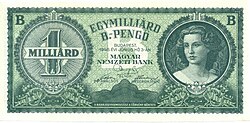Hyperinflation
In economics, hyperinflation is inflation that is "out of control," when prices increase very fast as money loses its value.
One example of hyperinflation is in Germany in the 1920s. In 1922, the largest bank note was 50,000 Reichsmark, In 1923 the largest bank note was 100,000,000,000,000 Mark. In December of 1923 the exchange rate was 4,200,000,000,000 Marks to 1 US dollar.[1] These bank notes were so worthless that people would burn them in fires to keep them warm. The notes would burn longer than the amount of wood you could buy with them. Sometimes the rate of inflation was so high that prices doubled every two days. The Rentenmark was introduced to stop this problem. The exchange rate was set at 4.2 Rentenmarks to 1 US Dollar.
In Zimbabwe, the inflation rate was 231,150,888.87% in July 2008.
Hyperinflation Media
Hyperinflation in Venezuela represented by the time it would take for money to lose 90% of its value (301-day rolling average, inverted logarithmic scale)
The price of gold in Germany, 1 January 1918 – 30 November 1923. (The vertical scale is logarithmic.)
Germany, 1923: banknotes had lost so much value that they were used as wallpaper.
References
- ↑ "Bresciani-Turroni, page 335" (PDF). 18 August 2014. Archived (PDF) from the original on 12 September 2013. Retrieved 27 June 2015.







